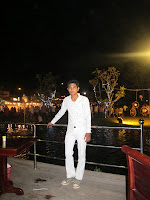

 Cambodian Cultural Village, the only Cultural Village in the country is “Cambodia in miniature” located in the historical province of Siem Reap. It was constructed to provide tourists, both local and foreign a glance of the country‘s famous and historical milestone as well as a showcase of the rich natural and cultural heritage of the Khmer people.
Cambodian Cultural Village, the only Cultural Village in the country is “Cambodia in miniature” located in the historical province of Siem Reap. It was constructed to provide tourists, both local and foreign a glance of the country‘s famous and historical milestone as well as a showcase of the rich natural and cultural heritage of the Khmer people.
Inside the extensive village are the representations of Cambodia’s 11 Villages featuring houses of different architectural styles while providing examples of Khmer creativity in arts and crafts. At each village, there are distinctive traditional dance performances traditional wedding ceremony, performance of ethnic minorities, Apsara Dancing, Circus, Acrobatic, popular games and especially the much awaited Grand Khmer Family white Night Shows. Wax museum exhibits the development of Cambodian Culture from the first century up to present, the way how Angkor Wat temple was built, Khmer people during the Chenla period, various characteristics and replicas of important historical people.
Cambodian Cultural Village is history, a representation of Cambodia only on a half day tour. - Wax Museum: Exhibits the famous Cambodian historical people from the first century up to the present. Showcases the antiques and lifestyle of Khmer people during the Angkor Period.
- Millionaire House: The Millionaire House is an ancient style of Khmer construction during the Ou Doung time. It is built from fine wood materials. The place where the most popular and must see traditional Khmer Wedding is performed.
- Souvenirs: All high quality souvenirs from different provinces in Cambodia made of sandstone, marble and wood reproductions for Angkorian era Quality silk products: wallets, handbags, scarves and cushions. Well designed jewelry and more are available at the Souvenir building. All of these are produced inside the Cambodian Cultural Village work-shops.
- Cham Village: The origin of Cham people is from Champa, Vietnam. Cham people mostly live along the riverbank and make their living by fishing and blacksmithing. The principle religion is Islam.
- Chinese Village: The Chinese people have moved to live in Cambodia more than thousand years ago during the Song Dynasty. Most of them are dealing by small business, crop and vegetable. The principle religion is Buddhism.
- Kola Village: Kola people, originally from Burma since 1870, are one of the minorities living in Pailin District, northwest of Cambodia where there are plenty of precious stones and peacocks. A dance called Pailin Peacock Dance is performed here highlighting the peacock’s activities.
- Kroeng Village: Kroeng people are the ethnic minorities living in the northeast of Cambodia, Rattanakiri province. They make their living by farming and hunting. They believe in Animism. “Fiancé Choosing Show” is performed in this village.
- Cambodian Immigrants to Oversea Village: The lifestyle of Cambodian people who live abroad. Features house and the church which shows the Christian religion.
- Khmer Village: Khmer are the main people of Cambodia. There are main models of houses of Khmer people. Wood and stone carving, clay pot making, palm sugar making, crafting, fishing and more are performed here especially Grand Khmer Family White Night show.
- Miniatures: Gathers all the miniatures of famous historical building and structures, former capital Ou Dong, Royal Palace, National Museum, Wat Phnom, Phsar Thmey, 12th century Kampong Kdey Bridge, 10th century reclining Buddha and more.
- Phnorng Village: One of the tribal groups living in the Northeast of Cambodia, Monduldiri Province. They make their living by farming and hunting. They believe in Animism. They are headed by Water & Fire Master who takes care of Preah Khan (Sword) which is granted by the ancient Khmer king. In this village “Water & Fire Master Choosing Show” is performed.
- Surin Village: Surin people are living along Cambodia and Thai border, next to Osmach District. Presently, they are in Thai territory but their Culture is not different from Khmer people living in the north of Siem Reap. They are good at organizing elephant matching they believe in Buddhism and some in Neak Ta Me Mut (witchcraft).
- Floating Village: Tonle Sap Lake is the big source of fishes which are the main food of Cambodian Peaople. The Villagers in this area make their living by fishing. They believe in Buddhism. Thei village where the “Fishing Show” is performed.
- Mini Theatre: It is building roofed by “Khunma” leaves. At the Min-theatre there are performance like classical dance, popular dance and circus etc…
- The unique, sprawling new cultural attraction in Siem Reap, intended to introduce the visitor to Cambodian culture and history. There are many types of houses in Khmer village such as house Peth, house Kantaing, house Raungdoeung, Sala Chan as a small pagoda… which are the main model houses of Khmer people. They make their living by farming, making palm sugar, rice storage, carving, weaving, crafting farm, making clay pot, fishing and popular games.
The Cambodian cultural villages has two museums that exhibit the well-know persons of Cambodia since the century until the present such as queen, king, general army, ambassador, monk, ethnic minority, movie star, Apsara dance and the way of how Angkor Wat temple was built by ancient Khmer, Khmer lifestyle during the Angkorian period and the breath-taking human figures with various paints. There are more than thirty wax statues that show about the development of Cambodian Cultural from the first century up to 20th century.
Cambodia has a long and rich tradition of classical dance, also know as Apsara dancing. Though some of the dance are shared with other cultures in the region. The slow graceful style of Cambodian dance is unique. There are many traditional performances you can see in the Cambodian cultural village in Siem Reap.













